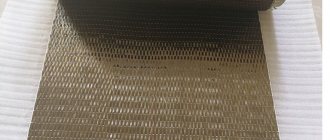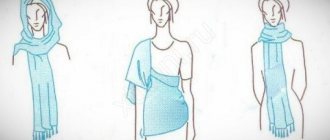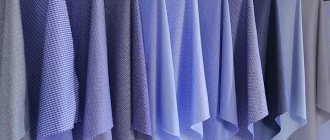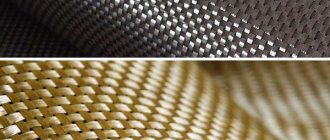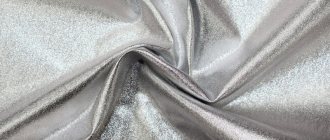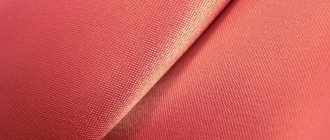The material has become widespread due to its softness, breathable structure, and pleasant tactility.
This is interesting: Until the 20th century, cashkorse was used to sew clothes for the poor. Its finest hour came with the advent of synthetics, which improved the quality characteristics of natural matter.
What type of fabric is cashcorse?
Cashkorse is a type of knitted fabric. It is practical, soft to the touch, comfortable to wear. The fabric has a knitted texture and looks like “English rib”. In it, the front and back loops are intertwined with each other in a ratio of 1:1, 2:2, 3:3. The material is knitted in a circle.
Shades of cashcorse fabric
Reviews
To have a complete idea of what kind of cashkorse fabric is, you need to read reviews of people who had the opportunity to work with this material or wore things made from it.
Antonina, 40 years old “I always sew clothes for my family myself. I use different materials, from which I make sweaters and blouses. I like the way these things wear, but I’ll say right away that if you have little sewing skill, you shouldn’t buy such fabric, it’s very capricious.”
Ekaterina, 30 years old “I have a dress made of this material. I really like the way the outfit fits, but caring for it is a pain. If you don’t keep track of the temperature of the water when washing, you wash it on the wrong cycle and the dress will lose its shape.”
Add our site to bookmarks, rest assured, we will surprise you with materials that will be even more interesting. Next, be sure to read our article and you will find out after what time you need to change your bed linen.
Origin story
Linen appeared in 1775, when Joseph Crane invented a special machine for fabric. Due to a lack of funds, the mechanic sold the device. The new owner was businessman Richard March. He patented the machine in his name, and the device was first used for knitting stockings.
With the advent of knitwear in the early 20s. In the 20th century, cashkorse began to be actively used in tailoring. Fashion designer Jean Patou was the first to use it. One of the inventor's collections contained various knitted fabrics.
Now the fabric is produced in Russia, China and Turkey.
What material is sewn from?
The popularity of the fabric often raises questions among those starting to work with cashkorse: what kind of fabric is it and what is sewn from it. Making turtlenecks and sweaters, coats and cardigans, hats and sports socks - this is not a complete list. Higher density fabrics are used for hems and sleeves of coats and jackets. With a softer and more delicate texture, the fabric is used in sewing products for infants. Children's T-shirts and shorts, dresses and sweaters made from this material are worn by children with pleasure.
The ease of dry cleaning and wet washing of knitted fabric is in demand by young mothers. Interlock bedding sets absorb excess moisture, leaving the baby's skin dry. The fabric allows air to pass through, which does not lead to diaper rash and irritation.
You might be interested in Description of 3-thread fleece knitted footer: fabric characteristics
Children's knitwear
Composition and properties
The main component of this type of knitwear is cotton. In the production of things, the following is added to the material:
- elastane;
- viscose;
- lycra;
- polyester.
Elastane
Artificial elastane fabric: from production and properties to areas of use
more details
Viscose
Synthetic viscose fabric: from an overview of the properties and types of material to rules for caring for things
more details
Polyester
Popular synthetic fabric polyester: what is known about its characteristics and areas of application?
more details
Lycra
What is Lycra fabric and what are its features? What are the characteristics and areas of use?
more details
The main properties include:
- Air conductivity.
- Elasticity.
- Hygroscopicity.
- Resistance to stretching.
Advantages and disadvantages
Main advantages of the material:
- good hygroscopicity. The fabric absorbs moisture, so it is well suited for underwear;
- yarn strength. Products made from ribana are resistant to mechanical defects. This characteristic is obtained thanks to the weaving method - cross-knitting with double weave of yarn;
- Wear resistance and durability during operation. After washing, things do not shrink or wrinkle and keep their shape. Over time, pellets do not appear. If the fabric has a fleece, then such things can be used in winter;
- gives high thermoregulation. The material does not compress the body and retains heat well.
You might be interested in this. Detailed description of tarpaulin: material features
Attention! Natural material has only three disadvantages. Items made from ribana take a long time to dry. The canvas does not tolerate ultraviolet rays well and fades in the open sun. The texture of smooth fabric is quite easy to spoil with improper care.
Eraser+ribana
Kinds
The following types of material exist:
- Penya is a knitwear consisting of 95% cotton and 5% elastane. Density is 300 g/m². There are all kinds of them - this is the softest fabric, which is more valued than others and has a high cost.
- Ring – contains 95% cotton and 5% lycra. It has a density of 210 g/m².
- Open End – has a composition similar to that of a ring and is characterized by high density. Because of this, it is used when sewing outerwear.
- Cashkorse cotton - consists of 100% cotton, used in sewing children's clothing and underwear.
- Acrylic cashcorse - consists of 95% cotton and 55% lycra. Additional clothing parts are sewn from the fabric - collars, cuffs.
- Brushed - the composition of the fabric is 95% cotton, 5% lycra. The fleece is located inside and provides additional warmth. The fabric is used to make cardigans, sweaters, winter socks, sweaters, and leggings.
- Kashkorse-polyester – has 70% polyester and 70% cotton. It is used to process parts of outerwear and things that should, first of all, be elastic.
- Without brushing - a fabric with 10% lycra and 90% cotton. This is a universal fabric that is used in sewing all types of clothing.
- Cashkorse-viscose - has 75% cotton, 22% polyester and 3% viscose. The material is used to create outer knitwear.
Application area
The scope of use of cash corse is wide. The intended purpose is largely determined by the type of fabric. All types have one thing in common: in the textile industry they are used for making clothes.
| View | Application area |
| Cotton cashcorse | Children's clothing, including items for newborns. Naturalness allows you to create an optimal microclimate, thanks to unhindered air circulation and moisture removal. |
| Polyester | A sports uniform that does not restrict movement and does not float the body. |
| Viscose | Comfortable, elastic T-shirts, tank tops. They can be used independently or be part of a multi-layered ensemble. In both cases, comfort is ensured: they are cool in summer, and they keep warm in winter. |
| Peña | Children's things, underwear. Thanks to special processing, the singing acquires additional softness and tenderness. |
| Boxing ring | Casual clothing: sweaters, turtlenecks, cardigans. They look stylish and elegant, so they fit organically into business style. |
| Acrylic | Not used as a material for sewing whole products. Its purpose is finishing: trims, cuffs, trim along the bottom line. Moderately dense acrylic does not pinch the skin and does not interfere with free blood circulation. |
| OpenEnd | The fleecy fabric is ideal for outerwear. |
| With fleece | Headwear and accessories (scarves, mufflers, stoles), hosiery. |
| Without backcombing | Depends on the density, used for sewing casual clothes. |
| Milano | Dresses with hand-knitted texture, elegant suits. |
Advantages and disadvantages of cashcorse
The advantages include:
- preservation of the shape of the finished item made from cashcorse;
- lack of shedding;
- pleasant tactile sensations;
- the ability to let air through and allow the body to breathe;
- hygroscopicity, which ensures comfortable wearing of things;
- inability to cause allergies or skin irritations;
- strength;
- wear resistance;
- environmental friendliness due to the predominance of cotton in each variety;
- washability.
The disadvantages of cashcorse include:
- processing complexity;
- the need to strictly follow the rules of clothing care.
A few words about the shortcomings
Buyers leave positive reviews about Cash Corse. The disadvantages are not related to the quality characteristics of the material. Disadvantages include difficulties in sewing and cutting. But, if you remember a few simple rules used by professional seamstresses, you can forget about them forever:
- Be sure to use blunt-tipped needles when working. They should not pierce the Kashkorse, but gently push the loops apart, then there will be no problems with sewing.
- When cutting, you need to take patterns of a smaller size in width due to the elasticity of the cash-corse, and narrow the sleeves towards the hem line to completely fit the wrist.
- It is better for beginning seamstresses to choose plain fabrics until they gain the appropriate experience. Adjusting the pattern is a difficult matter when working with cashcorse. Without certain skills it is difficult to cope with this. As a result, you can get an unaesthetic appearance of the finished product.
Special care for the fabric also causes dissatisfaction. If washed or ironed incorrectly, the products will quickly lose their presentable appearance, softness, and shape.
Manufacturing standards
The production of cashcorse fabric is regulated by GOST 28554-90. The regulatory document states:
- characteristics of the fabric: what should be the density, abrasion resistance, grade, what equipment it is produced on;
- labeling: how to label products, what information is indicated on the labeling label, how the labeling is applied;
- requirements for raw materials: the fabric is made from synthetic and natural fibers;
- test methods: how the characteristics of the fabric are determined: density, cutting, etc.;
- transportation;
- fabric storage.
Care
Any elastic item requires proper care. When buying a product made from cashcorse knitwear, it is important to know the intricacies of washing and care so that it lasts longer:
- It is recommended to wash the fabric at a temperature not exceeding 40⁰.
- It is better to wash the product by hand, but if it is bulky, then use the delicate machine wash cycle.
- Spin the knitwear at minimum speed.
- You need to iron your clothes from the wrong side.
- It is better to dry bulky items in a horizontal position.
Advice! Although knitted items are resistant to powders and retain their brightness and color saturation, still use liquid washing gels. This will not only extend the shelf life of the product, but is also beneficial for the machine.
When purchasing clothes made from cashcorse, you can be sure of their strength and reliability. The fabric looks neat, is pleasant to the body, and allows it to breathe. A good solution would be to buy products from cashcorse both in winter and in summer. And hypoallergenic and natural nature will be appreciated by allergy sufferers and people with sensitive skin.
Price
Varieties of cashcorse have the following starting price:
- singing - 450 rubles;
- ring – 300 rub.;
- with fleece – 450 rubles;
- without backcombing - 250 rubles;
- Open End – 200 rub.;
- acrylic – 200 rub.;
- cotton – 550 rub.;
- viscose – 450 rub.
Kashkorse is actively used in sewing casual and special clothing. There are about 10 types of fabric depending on the composition. The main material for the production of cash corse is cotton. It also contains synthetic fibers. The price of the fabric is affordable. The canvas is low maintenance, so it is a good material for everyday wear.
Uncover
Basic rules and instructions:
- do not stretch the material during cutting;
- it is necessary to clearly distinguish between the transverse and lobar directions of the threads. It is advisable to sew only in such a way that the knitted loops are located along the fabric;
- you need to pay attention to how the material behaves after ironing and washing. Sometimes he can sit down. Then you need to note the size range and remember about shrinkage. It is advisable to indicate this on the product label;
You may be interested in what is special about mercerized cotton
Brushed ribana for cold weather
- you need to use machines for working with elastic fabrics. A knitting needle will have a more rounded end. This will reduce the risk of damage to the product;
- The fabric under the seam is stretching. In order for the product to be of much higher quality, it is necessary to use rib tape to avoid deformation of the clothing at the seams. Often, trims are sewn only on the shoulder seams and throat line.
The fabric is very easy to work with and does not require any great tailoring skills. It is enough to be able to make simple stitches. Therefore, it is perfect for beginner craftswomen who experiment with different elements of clothing.
How to calculate the length of the ribbed neckline
To calculate the length for the collar, you need to use the formula: divide the length of the collar by the number PI and subtract two neck widths. The result must be multiplied by the number PI.
Cotton and Lycra
Description of knit weave
They depend on the structure of the material and are:
- warp knitted type;
- cross-knitted (knitted).
Single knitted
In the first option, all base threads are involved in weaving. Each must be knitted separately. To form a cross weave, the threads are shifted. Fabrics obtained as a result of this type of manufacturing do not fray on the sides and have inclined loops. In this weave, a broach and a core are distinguished. This type includes:
- Tights. Tricot - with this type of knitting, a shift occurs by one needle through a row. That is, having knitted one row, the second is knitted with a shift, and the third as the first, returning the fabric to its original position. And so they alternate. The loops in the columns are formed by two adjacent fibers.
- Chain . When weaving with a chain, a vertical row of loops is made from a separate thread located on each needle. This is the most simplified type of weaving.
- Atlas . Satin weaving creates a zigzag pattern on both sides of the fabric by shifting the threads to one side and the other. The main thread is involved in the creation of each column. This weave helps the fabric to stretch across its width. This material will curl around the edge.
Cloth
Another type of warp weave is cloth. Its peculiarity is that the threads shift not to the adjacent needle, but to the second and third. This weave makes the outer side of the fabric sloppy, and therefore the reverse side is taken as the front side.

